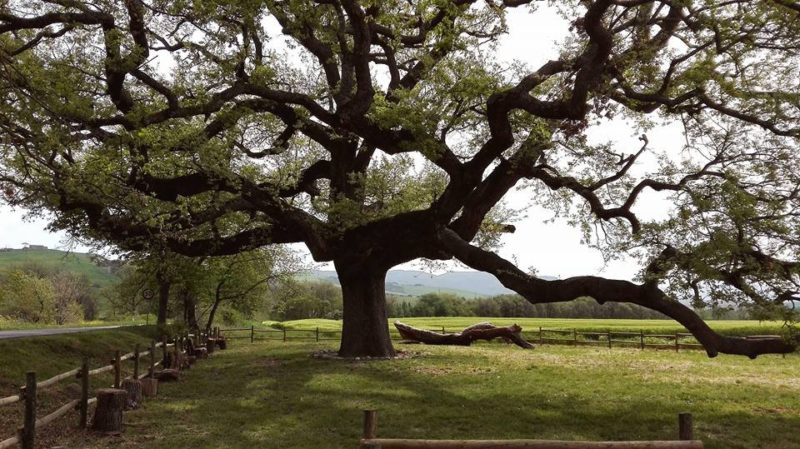
Checche Oak Tree
This post is also available in:
 Italiano (Italian)
Italiano (Italian)
Quercus pubescens (Fagaceae)
This marvellous solitary oak has a circumference of 15.25 ft, a height of 72.17, and it is 360 years old. Its dimensions are not as incredible as those of other downy oaks but what never fails to catch any visitor’s attention is the majestic foliage of this beautiful tree; the large and long branches run parallel to the ground, forming a crown that almost touches it, wider than the height of the tree.
In August 2014, a large branch broke and fell: the Italian Society of Arboriculture immediately treated the wound. Despite this, the monumental tree is in very good health and continues to boast its beautiful foliage year after year.
Its name come from magpies (“checche” in local Tuscan dialect).
This great tree is also known as “the oak of the witches”, as in the past, according to several legends, it used to be a meeting place for satanical rites.
The old oak witnessed the Second World War and, in particular, a fierce clash between the Italian partisan forces and the fascist army.
Unfortunately, a road runs a few feet from the tree: for this reason, the branches that usually fall on that very road were cut a few years ago, partly spoiling the perfect foliage of the oak tree.
How to get there:
Drive along the entire Val d’Orcia along the provincial road that leads from Bagno Vignoni to Radicofani. The downy oak is in the municipality of Pienza (FI), not far from “Le checche” farm – on the right of the road from Via Cassia.
Botanical Card
This species is found in many parts of the world and it is mainly found in the southern part of Europe. In Italy, the downy oak grows in all the regions.
The species is halophilic and xerophilic, it can withstand low temperatures but requires hot summers. It grows between 656 ft and 2.624 ft m of altitude, usually south-facing slopes. In particular, it thrives in dry woods and shrubs.
In the north of the peninsula, on calcareous, rocky and well-drained soils, it is associated with ash, hornbeam and black pine. In the centre and the south, it only grows in the lower part of the holm oak woods and in the upper part of the Turkey oak woods.
The wood of this species is harder and heavier than other oaks; its fibres tend to detach and for that reason, it is less favoured by carpenters and artisans. It burns perfectly and produces excellent coal.
Photo source: http://www.castellodispedaletto.it/pagine/I/cosa-fare/art000061/La-Quercia-delle-Checche
This post is also available in:
 Italiano (Italian)
Italiano (Italian)
Contatti
53026 Pienza(SI)
